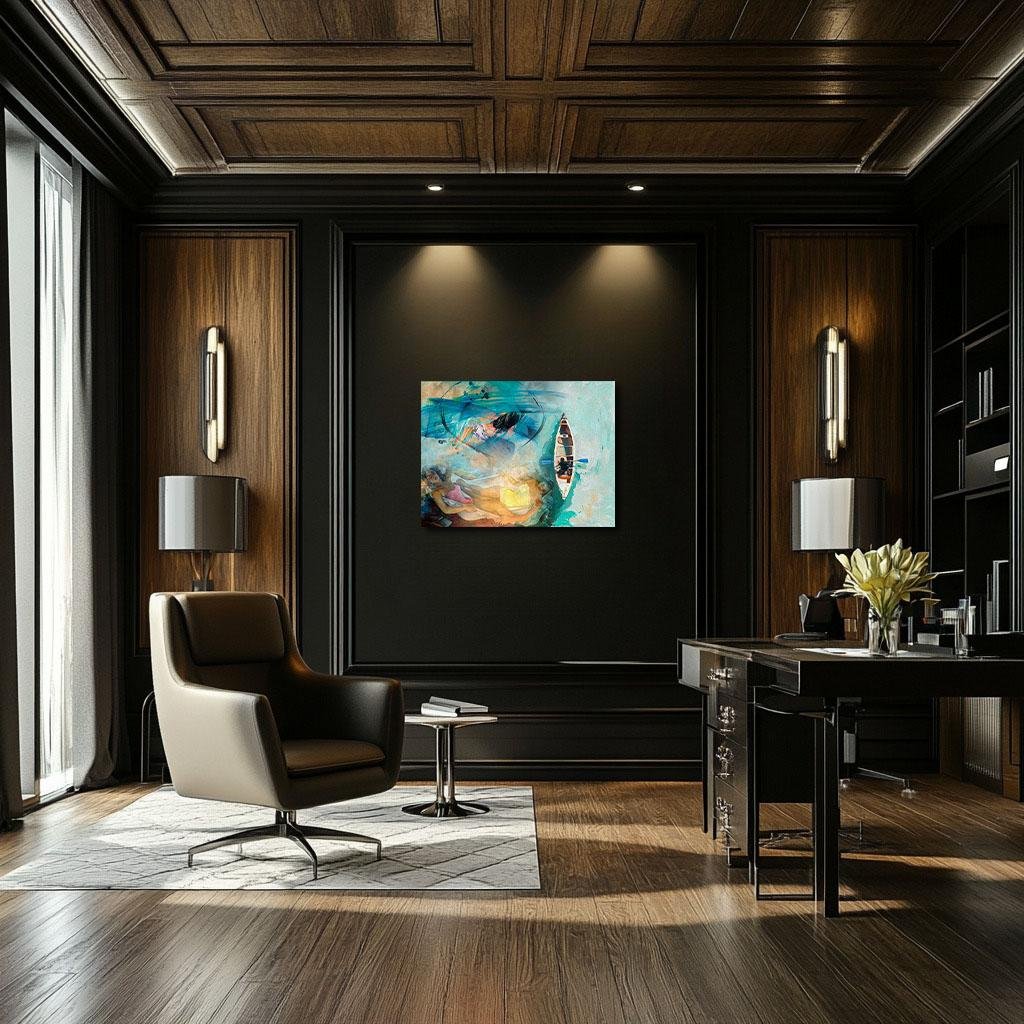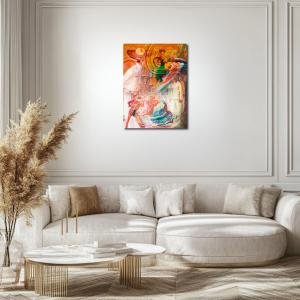The Hammock Drift: A Dream of Leisure and Motion
The Hammock Drift reimagines Diego Rivera’s intimate portrayal of rest into a surreal aquatic dream. Two women recline softly in a floating hammock, their serenity enveloped by swirling water, a solitary swimmer, and a drifting rowboat. Through gradients of turquoise, violet, and warm pastel tones, the piece explores the emotional dialogue between stillness and movement. Rivera’s tender moment of leisure expands here into a broader meditation on memory, labor, and the quiet tension of surrender.
Please see Below for Details…
Hotline Order:
Mon - Fri: 07AM - 06PM
404-872-4663
Diego Rivera’s original The Hammock , held at the Dolores Olmedo collection, captures a peaceful, sun-soaked moment of femininity and rest—a rare deviation from his politically charged frescoes. In this reinterpretation, titled The Hammock Drift , I expand Rivera’s domestic intimacy into a broader, aquatic narrative. The piece preserves the sensual stillness of the hammock scene but repositions it within a shifting, surreal environment of water, oars, and kinetic distortion. It is not merely a tribute to Rivera’s quiet ode to repose—it is a meditation on the dual nature of rest: as both grounding and adrift.
At the heart of the canvas, the two reclining women of Rivera’s original composition remain mostly untouched, their bodies soft and luminous, their dresses melting into the weave of the hammock. Yet they no longer exist in the stasis of a garden or home. Instead, they float as if suspended over or within translucent water, their outlines slightly blurred to suggest evaporation, memory, or the fragility of leisure itself. Their posture remains languid, yet now it appears less grounded—more ghostlike, perhaps even longing.
To the upper left, I’ve introduced a swirling, turbulent motion—a woman mid-stroke, swimming into the canvas from the abstract currents. Her form is dynamic, muscular, determined. She counters the softness of the resting women with urgency. This juxtaposition between the swimmer and the reclining figures creates the tension I sought in this reinterpretation: the friction between motion and surrender, activity and stillness, independence and ease.
To the right, an aerial view of a rowboat appears. A solitary figure rows, his back turned, absorbed in repetition. The boat cuts a diagonal through the otherwise fluid environment, bringing structure into the liquid chaos. It implies escape, or perhaps journey—a destination not yet revealed. This oarsman is a symbol of emotional labor, perhaps echoing Rivera’s lifelong concern with physical work. But here, in this surreal ocean of femininity and drift, he is alone, perhaps longing for contact with the softness he cannot reach.
Color was central to the emotional construction of this work. I bathed the entire composition in layered shades of turquoise, seafoam, and aquamarine—colors associated with water, memory, and emotional fluidity. These hues are not flat; they shimmer with light and dark variations, as if currents pass beneath them. The water around the women transitions from warm emeralds to glowing pale blues, suggesting warmth, reflection, and dreamlike calm. These colors envelop their bodies like silk or mist, echoing the way the hammock wraps around them.
The swimmer’s form is traced in deeper ultramarines and strokes of violet, marking her as a force of physical energy. She emerges from paint-like swells of blue-green abstraction—colors chosen to mirror both the ocean and the emotional churn of inner strength. Her palette feels colder than the women’s, and intentionally so. It speaks to effort, resilience, and the sense of swimming against invisible tides.
The rowboat stands out with clean contrast: a crisp white hull, warm wooden planks, and cool blue oars. These choices ground the viewer visually while also emphasizing the concept of control and navigation. The blue of the oars harmonizes with the surrounding water but is more saturated—like decisions cutting through ambiguity. Around the boat, light olive tones fade into thin brushstrokes, echoing watercolor textures to maintain the dreamlike environment.
Above all, this piece is an emotional conversation between different states of being. The reclining women represent the human desire for comfort, connection, and stillness. Their intertwined limbs, soft lighting, and pastel-toned garments evoke sensuality and the sacredness of pause. Yet around them swirls movement, isolation, and work. The swimmer, alone but active, asserts her agency in a world that wants her to be still. The rower, distant yet determined, paddles not just across water, but across the vast terrain of emotional distance.
When I created The Hammock Drift , I was inspired by the subtle yet profound shift in Rivera’s original work—a rare moment where women were not allegories of revolution or symbols of fertility, but simply themselves. Resting. Breathing. Existing. I wanted to preserve that softness, yet show how even peace is navigated. That no state of rest exists in isolation—it is always bordered by effort, longing, and motion. Rivera painted a still life of the human form. I painted the current that surrounds it.
Add your review
Your email address will not be published. Required fields are marked *
Please login to write review!
Looks like there are no reviews yet.








